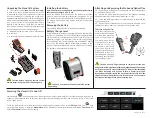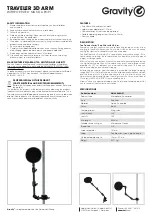
5
The five real time graphing screens include: SWR screen, Magnitude of Impedance screen,
Reactance screen, Resistance screen, and Vector screen. These screens contain a graphing
area, Data Box, and Logo Box (Figure1).
The graphing area is 100 pixels wide. It is bordered on the right by a vertical axis containing a
user-selectable scale, and on the bottom by a horizontal axis containing tick marks every ten
pixels. The center (longest) tick mark represents the center frequency (center of the plot).
The Data Box, which contains three (simple mode) to 12 (expert mode) data blocks, is located
below the horizontal frequency axis. The data blocks are updated after each frequency sweep,
center frequency adjustment, or width adjustment.
NOTE: A data block will display the acronym “NA” when numerical data is Not Available for a
particular value. This usually occurs when the SWR is too high or the Magnitude of Impedance is
too far from 50 ohms.
The Logo Box, located in the lower right hand corner of the display, contains a letter that identifies
the screen you are currently viewing. This box becomes vital in the expert mode when keeping
track of your location becomes a little more challenging. The following key lists the real time
screens and their identifying letters.
S………… SWR screen
Z………… Magnitude of Impedance screen (absolute value)
X………… Reactance screen (absolute value)
R………... Resistance screen (Real value of Impedance)
V………… Vector screen (rectangular display of Impedance, X vs. R)
D………... Data screen
N………… Numerical Entry screen (displays numbers entered on the keypad)
DEDICATED KEYS
The dedicated keys, which include all but the F1-F5 softkeys, are used to adjust operational
parameters.
The ON and OFF keys activate and deactivate, respectively, the Analyzer.
In the real time graphing screens, the WIDTH keys determine the frequency sweep range
represented in a plot (refer to Frequency Sweep Range section). To adjust this range, use the
WIDTH
p
and WIDTH
q
keys to step through eight preset width values (0kHz, 10 kHz, 20 kHz, 50
kHz, 100 kHz, 200 kHz, 500 kHz, 1 MHz).
When the width is set to 0 kHz, the unit will analyze SWR, Impedance, etc. at a single frequency
(center frequency value). In addition, a beep sound at a rate that is proportional to the SWR at the
center frequency (i.e. a low beep rate indicates a low SWR). This auditory cue allows you to
make antenna adjustments without having to visually consult the display.
The center frequency of a plot, which defines the midpoint of the frequency sweep range, can be
adjusted in three ways. One way is to use the FREQ
p
and FREQ
q
keys to step the center
frequency value up and down in increments one-tenth the width value. For example, when the
width is set to 500 kHz, the step size value will equal 50 kHz. Each time you adjust the width, the
step size value will also change. This automatic feature enables fine-tuning within a plot.
You can also use the number keys to enter new center frequency values. Simply input a value
between 0.001 and 54.000 MHz, followed by the ENTER key. Since the decimal point is in a fixed
position, zeros will precede any values that are less than five digits long (i.e. 00.545).
Summary of Contents for CIA-HF
Page 1: ...CIA HF Complex Impedance Analyzer Operating Manual ...
Page 24: ...21 ...









































